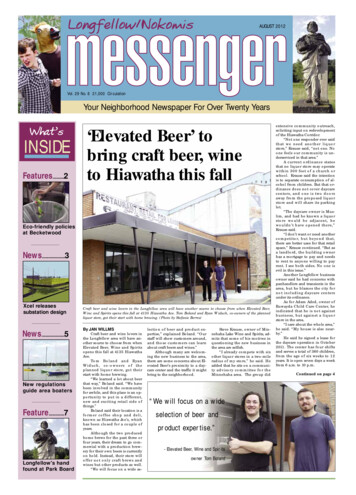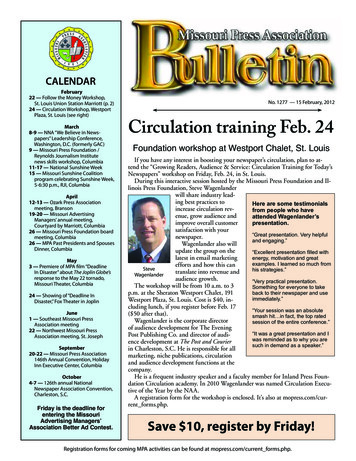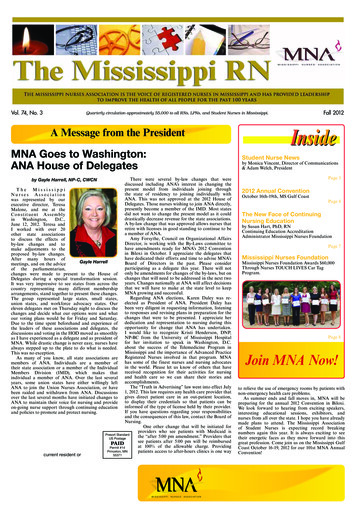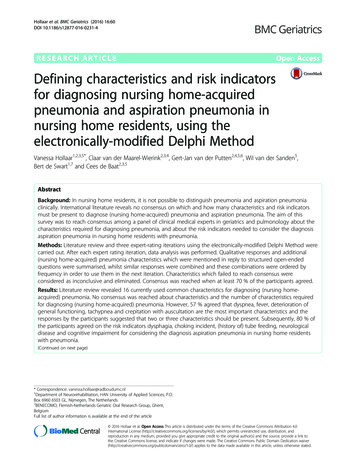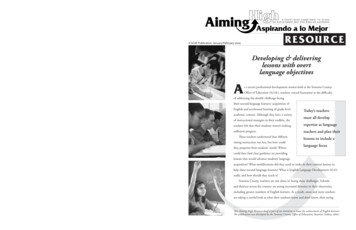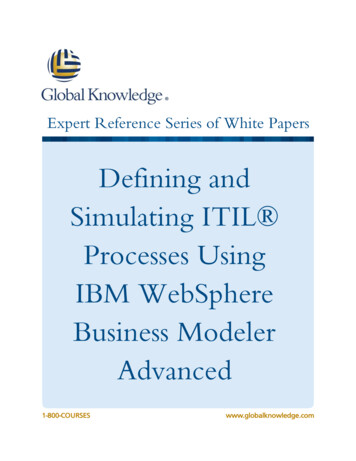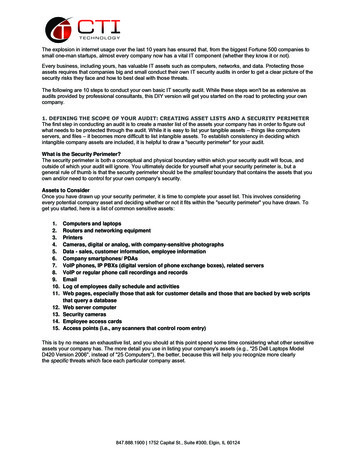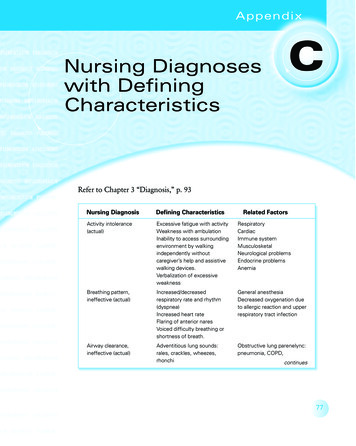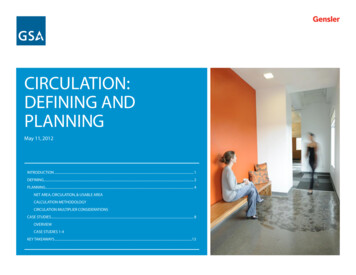
Transcription
CIRCULATION:DEFINING ANDPLANNINGMay 11, 2012INTRODUCTION. 1DEFINING. 2PLANNING. 4NET AREA, CIRCULATION, & USABLE AREACALCULATION METHODOLOGYCIRCULATION MULTIPLIER CONSIDERATIONSCASE STUDIES. 8OVERVIEWCASE STUDIES 1-4KEY TAKEAWAYS.13
INTRODUCTIONIf the amount of area dedicated to circulation isunderestimated, the programmed Usable Areamay not reflect the amount of space needed toaccommodate the envisioned workplace.Determining an organization’s space needstypically begins by itemizing the various spacetypes, their area, and quantity. The subtotal ofthis calculation, also known as Net Area, is thenadjusted to take into account pathways leadingto and in-between the different types of spaces.This is accomplished by applying a CirculationMultiplier, which takes the form of 1.## (e.g., 1.50),to the Net Area. The resulting subtotal becomesthe total Usable Area for the organization andforms the starting point in the design andplanning for a new workplace.Despite this seemingly straight forwardapproach, Circulation Area is often underestimated. For decades, facility planners,designers, architects, and real estateprofessionals have adjusted the CirculationMultiplier in order to achieve a targetUsable Area, rather than reducing the spacerequirements for individual and support spaces.However, circulation is a necessary componentof a space program. If the amount of areadedicated to circulation is underestimated, theprogrammed Usable Area may not reflect theamount needed to adequately accommodatethe new workplace.May 11, 2012Circulation: Defining and Planning is an attemptto bring clarity to this topic. It exploresterminology, the difference between CirculationMultipliers and Circulation Factors, and arecommended method to estimate and plan forcirculation.This document also explains, through the useof case study examples, how to evaluate abuilding’s efficiency by calculating the actualcirculation. It’s worth noting that the casestudies and examples shown in this documentare illustrated on full floor tenants, rather thanmulti-floor tenancy, for ease of explaining theconcepts. They also use ANSI / BOMAZ65.1-1996, “Standard Method for MeasuringFloor Area in Office Buildings”, as the basis forterminology definitions.Circulation: Defining and Planning consists offour sections:DEFININGAdopting a common language about circulationPLANNINGDetermining how to use the right CirculationMultiplier for a projectCASE STUDIESDemonstrating the impact of circulation incompleted projectsKEY TAKEAWAYSFactors that should always be considered whencalculating the Circulation AreaCirculation: Defining and Planning1
DEFININGA common language about office space.FD.FD.NET AREA (NET SQUARE FEET - NSF)CIRCULATION AREA (PRIMARY & SECONDARY)The area of each identified program space. For example,the Net Area of an 8’ x 8’ workstation is 64 NSF. It includesindividual workspaces, dedicated and shared support spaces,and special mission-critical spaces.Primary circulation is the main circulation route connecting tothe building core and common spaces, such as elevators andexit stairs. Secondary circulation includes the aisles betweenindividual spaces, such as offices and cubicles, and support spaces.FD.FD.FD.USABLE AREA (USABLE SQUARE FEET - USF)*RENTABLE AREA (RENTABLE SQUARE FEET - RSF)*GROSS AREA (GROSS SQUARE FEET - GSF)*Area of a floor occupiable by a tenant where personnel orfurniture are normally housed.Total Usable Area plus a prorated allocation of the floor andbuilding common areas within a building.Total area of a building enclosed by the exterior face of theperimeter walls, calculated on a floor-by-floor basis.* Definitions per ANSI/BOMA Z65.1 - 1996, “Standard Method for Measuring Floor Area in Office Buildings”May 11, 2012Circulation: Defining and Planning2
DEFININGA common language about office space.NET AREA (NSF)FD.What it IncludesHow it is MeasuredWhen is it UsedIncludes workspaces (office and workstations),dedicated support (conference rooms, supplyrooms, etc.), shared support (shared copier rooms,break rooms, etc), and special mission-criticalsupport spaces (evidence rooms, laboratories,courtrooms, etc.)Measure to the centerline of interior partitionsof a space. Total Net Area is calculated by addingtogether all programmed areas. Space Programming Space Standards/Guidelines Tenant ImprovementsCirculation Area can be broken into two types:primary and secondary. Primary circulation isthe main route connecting the building core andcommon spaces, such as elevator lobbies, exitstairs, and core toilets. Secondary circulation is theaisles between individual and support spaces.Based on the ratio of enclosed spaces to openspaces, a Circulation Multiplier is estimated andapplied to the total Net Area to determine theCirculation Area. Space Programming Space Standards/Guidelines Tenant ImprovementsIncludes Net Area and Circulation Area, butexcludes building core and common spaces suchas elevators, exit stairs, mechanical rooms, and coretoilets. For multi-tenant floors, common buildingcorridors are excluded from Usable Area andinstead, are included in the Rental Area.See ANSI/BOMA standard* for detailed calculationmethod. Generally speaking, measure thearea enclosed between the finished surfaceof the office area side of corridors and thedominant portion of the exterior walls or verticalpenetrations.CIRCULATION AREAFD.Planning Formula: Circulation Area NSF x (CirculationMultiplier - 1)USABLE AREA (USF)*FD.Planning Formula: USF NSF Circulation AreaRENTABLE AREA (RSF)*FD. Space Programming Space Standards/Guidelines Tenant ImprovementsUsable Area and building common spaces, such asthe building lobbies, egress corridors, service spaces(mechanical/electrical, toilet, janitorial, etc), andloading docks. Excludes major vertical penetrations,such as stairwells, elevators, and major shaft spaces.See ANSI/BOMA standard* for detailed calculationmethod. Generally speaking, add the usable areato building common spaces while excluding majorvertical penetrations.Includes exterior wall thickness, and all verticalpenetrations (mechanical/electrical, plumbing,elevator shafts, stairwells, etc.), as well asbasements, garages, and penthouses. Excludesparking lots and loading docks outside thebuilding line.See ANSI/BOMA standard* for detailed calculationmethod. Generally speaking, measure to theoutside finished surface of permanent outerbuilding walls. Commercial Leases Rent CalculationPlanning Formula: RSF USF prorated share of Building CommonAreaGROSS AREA (GSF)*FD. Construction Real Estate PortfolioPlanning Formula: GSF RSF Vertical Penetrations and BuildingExterior Walls* For additional details on these definitions and space calculation methods, please refer to ANSI/BOMA Z65.1-1996, “Standard Method for Measuring Floor Area in Office Buildings”.May 11, 2012Circulation: Defining and Planning3
PLANNING: NET AREA, CIRCULATION, & USABLE AREAA Circulation Multiplier is applied to the Net Area to estimate the amount of Circulation Area that should beincluded in the Usable Area.INDIVIDUAL WORKSPACE UNITSPrivate OfficesWorkstationsTouchdown StationsSUPPORT SPACE UNITSGENERALPrint/CopyStorage/SupplyBreak RoomQTY OFEACH UNITXNSF/UNITTOTALNET AREA(NSF)CIRCULATIONMULTIPLIER(CM)TOTALUSABLE AREA(USF)COLLABORATIONConference RoomsOpen Meeting AreasMISSION SPECIFICLabs, Courtrooms, Secure Evidence Storage, etc.May 11, 2012Circulation: Defining and Planning4
PLANNING: CALCULATION METHODOLOGYThe proportion of open to enclosed spaces is the best gauge for determining a Circulation Multiplier.CALCULATION METHODOLOGYCirculation Area is a function of the open and enclosed spaces that exist in the workplace. Whena floor plan is comprised of mostly open workstations, the Circulation Area will typically be agreater portion of the total Usable Area than a plan made up of primarily enclosed office spaces.A unique Circulation Multiplier should be chosen for each project after considering theanticipated proportion of open to enclosed spaces to be provided. Planners should avoidthe practice of using the same Circulation Multiplier on all workplace projects (see CommonMisconception at right). Care should also be taken to not confuse the Circulation Multiplierwith the Circulation Factor. The Circulation Multiplier is applied to Net Area. The CirculationFactor is the percentage of Usable Area that makes up the Circulation Area. This distinction isdemonstrated below:COMMON MISCONCEPTIONHistorically, a Circulation Multiplier of 1.35 applied to the NetArea was assumed to provide adequate space for circulation,regardless of the configuration of the building or the typeand ratio of open and enclosed spaces. However, when thismethod is used, the resultant Circulation Area is just 26% ofthe total Usable Area.The following calculation illustrates this distinction usinga total Net Area of 28,000 square feet and a CirculationMultiplier (CM) of 1.35:CIRCULATION AREA 17,000 NSFLegendPERSONNEL SUPPORT 28,000 NSFLegendEXAMPLE REQUIREMENT: 45,000 USFNSF CIRCULATION AREA USF28,000 17,000 45,000NSF CIRCULATION AREA CIRCULATION MULTIPLER (CM)28,000 17,000 1.65CIRCULATION USF CIRCULATION FACTOR (CF)17,000 45,000 37.8%1.65MULTIPLIERMay 11, 201237.8%FACTORNSF CM USF28,000 x 1.35 37,800USF - NSF CIRCULATION AREA37,800 - 28,000 9,800CIRCULATION AREA USF CF9,800 37,800 25.9%1.35 25.9%MULTIPLIERFACTORAs subsequent case studies will illustrate, this CirculationMultiplier can be appropriate when the total Net Area isprimarily composed of enclosed spaces, such as privateoffices. In open workplace settings however, a CirculationMultiplier of 1.35 will often be insufficient.Circulation: Defining and Planning5
PLANNING: CIRCULATION MULTIPLIER CONSIDERATIONSThere are many factors that can affect circulation, such as: Large Enclosed Support and Special Spaces,Open to Enclosed Workspace Ratios, and Building Design and Efficiency.LARGE ENCLOSED SUPPORT AND SPECIAL SPACESLarge EnclosedSupport SpacesIf an organization’s program includes largesupport spaces (e.g., training rooms, storage) orspecial mission-critical spaces (e.g., courtrooms,law libraries), the requirement for CirculationArea may be reduced. Large enclosed roomsgenerally incorporate internal secondarycirculation within the program area and requireless additional circulation than a comparabletotal area of smaller clustered workstations.BBFBBBBBBFBBBBFFFBBBBFBBBFFFBBBFBFFBB BF1.37MULTIPLIER27%FACTORLegendOPEN TO ENCLOSED WORKSPACE RATIOSThe amount of circulation that is needed for afuture workplace is strongly correlated to theratio of open workstations to enclosed privateoffices. The quantity and unit footprint areaof open plan workstations impacts circulationsince they require proportionally greatercirculation than larger, enclosed spaces. Also,as workstations are constructed of fixed, usuallyrectilinear elements, the need to plan aroundcolumns or building irregularities can hinderefficient layouts.May 11, 2012100% OPEN1.62MULTIPLIER38%FACTOR100% ENCLOSED1.39MULTIPLIER28%FACTORCirculation: Defining and Planning6
PLANNING: CIRCULATION MULTIPLIER CONSIDERATIONSBUILDING DESIGN AND EFFICIENCYThe efficiency of a floor plate can vary dependingon the location of the building core, theregularity of column spacing, or the buildingconfiguration. Historic building floor plates areoften less efficient due to column sizes and thebuilding configuration. Some modern buildingsalso provide unique irregular floor configurationchallenges.Even with the most efficient layout, there may bea mismatch between the building module andthe tenant’s standard office depths or workstationdimensions. This can result in inefficientconfigurations and thus, a greater amount ofunaccounted for circulation space.May 11, 2012PLANNING FOR CIRCULATIONWorkplace requirements are developed early in the planningprocess and often before a building is selected. As such, aCirculation Multiplier (CM) should be selected based on theanticipated amount of Circulation Area that will likely beneeded given a typical building design and efficiency.A Circulation Multiplier of 1.4 can be used if there is a muchgreater portion of enclosed offices and support spaces.Conversely, a Circulation Multiplier of 1.6 should be used ifthe space is a predominantly open plan or if the buildingfloor plate is highly irregular. To further compensate foranticipated inefficiencies in building floor plate choices,a penalty or “fit” factor may be added to the CirculationMultiplier as a type of contingency.RECOMMENDED RANGESCIRCULATION MULTIPLIER (CM)1.4 - 1.6RANGE1.5AVERAGECIRCULATION FACTOR (CF)28 - 38%RANGE33%AVERAGECirculation: Defining and Planning7
CASE STUDIES: OVERVIEWThe floor plans of four different organizations, representing a range of different office configurations,were analyzed to understand the impact of open to enclosed ratios on circulation.To illustrate the impact of open andenclosed workspace ratios on theCirculation Multiplier, GSA commissionedGensler to provide case studies from fullfloor tenants, whose profiles range from100% enclosed offices to 100% openworkstations. This section presents fourcase studies that demonstrate workplaceenvironments which provide minimalcirculation space and others that providemore generous Circulation Area toencourage informal staff interaction andcollaboration.These case studies further explore therelationship between workspace typeand circulation in existing buildings. Thecorresponding Circulation Multipliersrepresent a rounded range of 1.4 to 1.6,and can be used to more accuratelydetermine the Circulation Area that willbe needed for a future workplace. Asa general rule, plans with a higher ratioof open to enclosed workspaces alsorequire higher Circulation Multipliers dueto the increase in seat capacity per floor.May 11, 2012Each case study plan is annotated withthe following: percentage of open plan workstationsto enclosed offices total Usable Area total seat count on the floor Circulation Multiplier Circulation FactorIt should be noted that the indicatedCirculation Multipliers and CirculationFactors are based on as-built circulationas a percentage of the total Usable Area.They are not necessarily the numbersthat were used during pre-designprogramming to estimate the amount ofspace that would be needed.CIRCULATION COMPARISON BETWEEN PLAN TYPESCASE STUDY SE STUDY SE STUDY SE STUDY rculation: Defining and Planning8
CASE STUDY #10% OPEN / 100% ENCLOSED USABLE AREA: 23,000 USFENCLOSED OFFICESOPEN WORKSTATIONSOBSERVATIONA floor plan with a large number of private officesand enclosed spaces requires less circulation, but alsoaccommodates fewer headcount.May 11, 2012SUPPORT SPACECIRCULATIONFLOOR CALCULATIONSOPEN0%ENCLOSED100%BASE PLANCIRCULATION CALCULATIONS79SEAT COUNT1.39MULTIPLIER28%FACTORCirculation: Defining and Planning9
CASE STUDY #233% OPEN / 67% ENCLOSED USABLE AREA: 33,000 USFDFDFDFDFDNUPDNENCLOSED OFFICESOPEN WORKSTATIONSOBSERVATIONEven workplaces with an open to enclosed ratio of 1:2can possess a fairly low Circulation Area because thefloor plan is predominantly enclosed offices.May 11, 2012UPSUPPORT SPACECIRCULATIONFLOOR CALCULATIONSOPEN33%ENCLOSED67%138SEAT COUNTBASE PLANCIRCULATION CALCULATIONS1.41MULTIPLIER29%FACTORCirculation: Defining and Planning10
CASE STUDY #380% OPEN / 20% ENCLOSED USABLE AREA: 45,000 USFdnegeLENCLOSED OFFICESOPEN WORKSTATIONSOBSERVATIONA predominantly open plan requires a higher percentageof Usable Area for circulation, but also accommodates ahigher capacity of seats on a floor.May 11, 2012SUPPORT SPACECIRCULATIONFLOOR CALCULATIONSOPEN80%ENCLOSED20%221SEAT COUNTBASE PLANCIRCULATION CALCULATIONS1.61MULTIPLIER38%FACTORCirculation: Defining and Planning11
CASE STUDY #4100% OPEN / 0% ENCLOSED USABLE AREA: 29,000 USFCOLLABORATESOCIALIZEENCLOSED OFFICESOPEN WORKSTATIONSOBSERVATIONIn addition to addressing necessary open plancirculation, a higher Circulation Multiplier can alsoprovide impromptu meeting spaces for socializing,learning, and collaboration.May 11, 2012SUPPORT SPACECIRCULATIONFLOOR CALCULATIONSOPEN100%ENCLOSED0%203SEAT COUNTBASE PLANCIRCULATION CALCULATIONS1.62MULTIPLIER38%FACTORCirculation: Defining and Planning12
KEY TAKEAWAYSWhile this report explores many different attributes and factors affecting circulation, there are fourkey takeaways that should always be considered.KEY TAKEAWAY #2The Circulation Multiplier (CM) and Circulation Factor (CF) are notsynonymous. While the Circulation Factor represents the percentage of UsableArea space that consists of Circulation Area, the Circulation Multiplier is usedduring the planning process to determine the total Usable Area. For example, aCF of 35% of the Usable Area would require a CM of 1.54, not 1.35.KEY TAKEAWAY #3Circulation Area is a necessary component of the workplace and should not beunderestimated. An inadequate amount of circulation could introduce problemswithin the workplace, such as inefficient traffic flow or a sense of overcrowding. Itcould also create insufficient area to accommodate an organization’s space needs.It is for these reasons that reducing the Circulation Area to meet an overall spacegoal should be avoided. A unique Circulation Multiplier should instead beestimated based on the types and quantities of spaces to be provided. Further,the following Key Takeaways should be kept in mind when planning for a futureworkplace:While there are many possible factors that may affect the selection of an appropriateCirculation Multiplier, the ratio of Open to Enclosed workspaces has the mostconsistent correlation to the required amount of Circulation Area. CirculationMultipliers will typically range between 1.4 to 1.6. As the portion of open workspaces increases, the Circulation Multiplier will also correspondingly increase.KEY TAKEAWAY #4The Circulation Multipliers addressed in the preceding case studies are basedon moderately efficient buildings. If occupancy in an inefficient building isanticipated, which can be attributed to such factors as column spacing andfloor configuration, the Circulation Multiplier should be further increased tocompensate for the likely need for greater Circulation Area.KEY TAKEAWAY #1The Circulation Area should not be compromised. As a general planning “ruleof thumb,” Circulation Area comprises roughly 25 to 40% of the total Usable Area.Planning for this allotment will better ensure that the programmed Usable Areawill represent the space needed to accommodate the future workplace, in mostfairly efficient buildings.May 11, 2012Following the approaches presented in Circulation: Defining and Planning willcreate more predictable space programming estimates and ultimately, a moreefficient workplace. For additional details about utilizing Circulation Multipliersor other aspects of this report, please contact the GSA Public Buildings Service atworkplace@gsa.gov.Circulation: Defining and Planning13
U.S. GENERAL SERVICES ADMINISTRATIONPUBLIC BUILDINGS SERVICE1800 F STREET, NWWASHINGTON, DC 20405WWW.GSA.GOVMay 11, 2012Circulation: Defining and Planning14
May 11, 2012. Circulation: Defining and Planning 1. Determining an organization’s space needs . typically begins by ite

